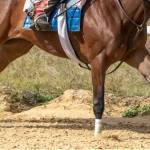Perks of PET for Diagnosing Injuries in Horses

A new positron emission tomography (PET) scanner allows horses to be evaluated for injuries while standing, a significant improvement over older models that require horses to be lying down. The updated scanner optimizes patient safety and produces exemplary images, giving veterinarians the chance to diagnose injuries other imaging modalities might miss.
PET scanning is a valuable imaging modality that can be used in conjunction with or instead of other imaging techniques such as nuclear scintigraphy (bone scanning), and magnetic resonance imaging (MRI). Horses are injected with a small amount of a tracer called 18F-NaF that localizes in bone. This is similar to bone scanning, which uses a tracer known as technetium. Unlike bone scanning, however, PET produces a detailed three-dimensional image of the anatomic region of interest.
Tracers are detectable in chemical and biological systems–in this case, the skeletal system–and are used to highlight specific material for study, allowing researchers to track the tracer’s progress through a system or to determine its distribution within a system.
“Preliminary studies using this improved PET scanner confirmed that 18F-NaF tracer uptake occurs in the fetlock, a joint where catastrophic injuries in Thoroughbreds often occur. In fact, some horses had 18F-NaF uptake on PET that did not have any on other imaging modalities, suggesting higher sensitivity,” shared Kathleen Crandell, Ph.D., a nutritionist for Kentucky Equine Research.
Importantly, 18F-NaF PET scanning also recognizes changes early in the disease process, allowing for modifications in training and racing that may prevent catastrophic injuries. Further, PET scanning can also help identify causes of lameness in hooves.
In a follow-up study, six Thoroughbreds (part of a research herd at the University of California, Davis) were serially scanned, as were six client-owned horses with lameness. PET scans in all 12 horses concentrated on the front fetlock joints.
All of the front fetlock joints were successfully imaged using the new PET scanner. Of the 94 attempted scans, 13 (14%) were imperfect due to patient noncompliance, with a single horse responsible for six of them. Even when the scans were imperfect, useful information was obtained. In this study, 90 of the 94 scans were analyzed by radiologists.
“Horse movement occurred in a small number of patients. Safety features activated secondary to that motion, releasing the horses without injury or damage to the scanner. Each of the horses was subsequently repositioned and successfully scanned,” Crandell said.
Only about 8% of the scans were judged to be “poor quality,” which was primarily due to inadequate tracer uptake. In this study, though, most of the scans with poor uptake occurred in a single horse. In addition, scan duration and field of view had some effect on image quality. The data suggested that four-minute scans with a 12-cm field of view were optimal for fetlock imaging in standing horses.
Substantial agreement between the two radiologists evaluating the scans was observed. While evaluating the clinical significance of tracer uptake was not one of the goals of this study, more client-owned racehorses had tracer uptake than the six research horses. This was thought to be a result of stress remodeling that occurs in horses during training.
“When young horses start race training, an adaptation period occurs during which the bone remodels to adjust to the strain of concussion. During that vulnerable period, bone density decreases. Studies conducted at Kentucky Equine Research with Triacton demonstrated an increase in bone density among Thoroughbreds in race training, particularly during this vulnerable time,” Crandell explained.
*Spriet, M., L. Edwards, S. Arndt, S.S. Wilson, L.D. Galuppo, P. Stepanov, and D. Beylin. 2022. Validation of a dedicated positron emission tomography scanner for imaging of the distal limb of standing horses. Veterinary Radiology and Ultrasound:13078.








